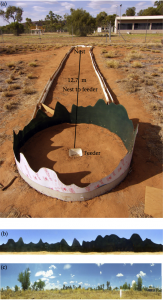If I am lost and need to find my way home, I grab my phone and turn on the GPS. However, animals do not have this option. They need to be able to find their way home based on their surroundings. Some animals, like migratory birds, do this with an internal compass based on magnetic information. Others, like ants, use visual cues, and remember landmarks that allow them to find their nest.
Different species of ants use different visual strategies for navigation, one of which uses the skyline to determine which direction they should walk. The skyline is where the earth meets the sky. Since the sky reflects much more short-wave ultraviolet (UV) light than terrestrial objects, it is thought that the skyline is often determined by either the change in level of UV reflectance, or by the ratio between the UV and green light available. Therefore, the amount of UV light should be important for this type of panoramic navigation.
To study this, Patrick Schultheiss and colleagues ran three experiments with a species of roaming desert ant, the red honey ant, Melophorus bagoti. They created an arena, where ants were trained to go between their nest and a plastic feeder. In the first experiment, the feeder was surrounded by an artificial panorama consisting of a green skyline and UV-blocking foil extending above it. The second experiment had just the UV-blocking foil but no artificial skyline, so the ants were able to use the natural skyline to guide their way. In the third experiment, a clear UV-blocking cutout in the shape of the training arena was placed at a new test site to see if that provided enough information for the ants to be able to orient themselves.
Overall, Schultheiss and his colleagues  found that when UV light was reduced in the panoramic view of the ants, they were significantly worse at navigating and finding their way home. If anything, they
found that when UV light was reduced in the panoramic view of the ants, they were significantly worse at navigating and finding their way home. If anything, they
went the opposite direction from the nest. Additionally, they were able to use the clear UV-blocking artificial skyline to orient themselves, even with no familiar natural skyline in sight. This suggests that the change in amount of ultraviolet light, whether intensity or the amount of it compared to green light, allows ants to find their way home by using the skyline. However, Schultheiss and colleagues point out that while this could be due to the change in UV reflectance, it could also simply be due to the change in brightness between the sky and the ground, suggesting that more data and future studies are needed.
Nevertheless, Schultheiss’ data support the idea that ultraviolet light plays a crucial role in ant navigation based on visual cues, due to its importance in differentiating between terrestrial objects and the sky. Ultraviolet light is not visible by humans, so it is often overlooked. This provides a clear example of how important it is to look beyond our personal experience, and take into account the sensory systems of the animals that are being studied. Especially since they don’t have smartphones.
Reference: Schultheiss, P., Wystrach, A., Schwarz, S., Tack, A., Delor, J., Nooten, S.S, Bibost, A-L., Freas, C.A., & Cheng, K. (2016). Crucial role of ultraviolet light for desert ants in determining direction from the terrestrial panorama. Animal Behavior 115: 19-28.
